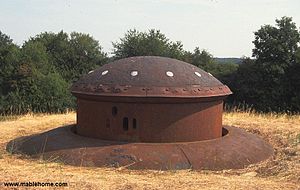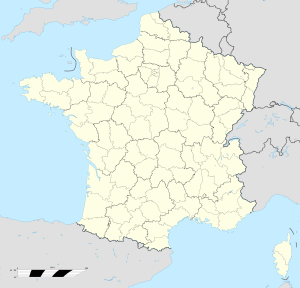- Ouvrage Immerhof
-
Ouvrage Immerhof Part of Maginot Line Northeast France 
Machine gun turret, Block 2Coordinates 49°25′30″N 6°08′08″E / 49.42508°N 6.13564°ECoordinates: 49°25′30″N 6°08′08″E / 49.42508°N 6.13564°E Built by CORF Construction
materialsConcrete, steel, deep excavation Current
conditionPreserved Open to
the publicYes Controlled by France Battles/wars Battle of France, Lorraine Campaign Ouvrage Immerhof Type of work: Small infantry work (Petit ouvrage - infantry) sector
└─sub-sectorFortified Sector of Thionville
└─Sub-sector of Hettange-GrandeWork number: A10 Constructed: 1930-1935 Regiment: 168th Fortress Infantry Regiment + 151st Position Artillery Regiment Number of blocks: 4 Strength: 193 enlisted + 5 officers Ouvrage Immerhof, also known as Ouvrage Ferme-Immerhof, is one of the largest petit ouvrages of the Maginot Line of northeast France. Located near the community of Hettange-Grande, it is 7 km north of Thionville between the gros ouvrages of Molvange and Soetrich, the closest ouvrage to the Luxembourg frontier. It was part of the Fortified Sector of Thionville, in the Fortified Region of Metz, the strongest portion of the Line. Apart from its function as a communication post between the neighbouring gros ouvrages, Immerhof also controlled the road and railway routes from Luxembourg, which pass in the immediate vicinity. In addition, Immerhof protected other Maginot works in the vicinity: the casemates of Kanfen, the infantry shelter of Stressling, the observation point and shelter of Hettange-Grande, and a number of nearby blockhouses constructed during the Phoney War.
Built between 1930 and 1935, Immerhof saw little action. After a renovation for continued use after World War II, the position was sold to the nearby community of Hettange-Grande in 1974 for use as a museum.
Contents
Design and construction
The Immerhof farm site was surveyed by CORF (Commission d'Organisation des Régions Fortifiées), the Maginot Line's design and construction agency, in 1930. Work by the contractor Duval of Nancy began in 1931,[1] and the position became operational in 1935,[2][3] at a cost of 31 million francs.[4][5]
Immerhof was the only ouvrage to be built using entirely cut-and-cover techniques, with no tunnelling, due to poor soil conditions.[6] A high water table meant that the drinking water well was only 28 metres (92 ft) deep; no deep drain could be constructed under the galleries due to the shallow water table.[7] The position was constructed entirely in reinforced concrete, as opposed to unreinforced mass concrete, causing a significant cost increase.[3] It was named after a nearby farm.[1]
Description
The ouvrage[nb 1] consists of four closely grouped combat blocks. The underground barracks is arranged in a unique two-level configuration.[10]
- Block 1: Infantry block with two GFM cloches and one machine gun turret.[11]
- Block 2: Infantry block with two GFM cloches and one machine gun turret, mirroring Block 1.[12]
- Block 3: Infantry block with one GFM cloche, one 81mm mortar turret, four machine gun embrasures and one machine gun/47 mm anti-tank gun embrasure (JM/AC47), with an emergency exit.[13]
- Block 4: Entry block with two GFM cloches, one grenade launcher cloche, four machine gun embrasures and one JM/AC47 embrasure.[14]
Casemates, observation points and shelters
The Observatoire de la Route du Luxembourg is located to the east, very close to Soetrich, in a position to watch the main road to Luxembourg. It was equipped with an observation cloche and a GFM cloche. Just to the south is the Abri de la Route du Luxembourg[nb 2], which sheltered a section of infantry that supported the observatory and the flank of the ouvrage.[16] While in close proximity to Soetrich, these fortifications actually reported to Immerhof.[3]
Several other casemates, observatories and infantry shelters are located around Soetrich, including
- Observatoire de Hettange-Grande: One observation cloche and one GFM cloche.
- Abri d'Hettange-Grande: Surface shelter for two infantry sections and a command post, with two GFM cloches.
- Abri du Stressling: Surface shelter for one infantry section, two GFM cloches.
- Abri de l'Helmreich: Sub-surface shelter for two infantry sections and the quarter command post, two GFM cloches.
None of these are connected to the ouvrage or to each other. All were built by CORF.[1] The Casernement de Hettange-Grande provided peacetime above-ground barracks and support services to Immerhof and other ouvrages in the area.[17]
History
- See Fortified Sector of Thionville for a broader discussion of the events of 1940 in the Thionville sector of the Maginot Line.
Immerhof saw little action during 1940, at most seeing harassing fire, resulting in the death of corporal Andé Rabu on 14 June.. German forces bypassed the area in the days leading up to the Second Armistice at Compiègne.[18] The Immerhof garrison, under the command of Captain Réquiston, surrendered to the German occupiers on 30 June, 1940, after rendering the fort's armament inoperable, the only Maginot position to sabotage its weapons prior to surrender.[19]
In the 1950s the French government became concerned about a possible invasion by the Warsaw Pact through Germany. Immerhof and many of the larger positions were renovated for further use. By 1953, Immerhof had become a part of the fortified môle de Rochonvillers along with Molvange, Rochonvillers and Bréhain.[20] After France's withdrawal from the NATO integrated command structure the ouvrage was abandoned. In 1974 the position was sold to Hettange-Grande as a museum.[21]
Current status
The ouvrage is maintained as a museum. It remains in a good state of preservation,[7] a condition attributed to the unusual attention given to drainage of groundwater while the site was open to the sky for construction, something not possible in tunneled positions.[3]
See also
Notes
- ^ English-language sources use the French term ouvrage as the preferred term for the Maginot positions, in preference to "fort", a term usually reserved for older fortifications with passive defensives in the form of walls and ditches.[8] The literal translation of ouvrage in the sense of a fortification in English is "work." A gros ouvrage is a large fortification with a significant artillery component, while a petit ouvrage is smaller, with lighter arms.[9]
- ^ An abri is an infantry shelter, sometimes underground or under earth cover. An abri in the main Maginot Line often closely resembles a casemate, but is more lightly armed and can hold more occupants.[15]
References
- ^ a b c Mary, Tome 3, p. 90
- ^ Kaufmann 2006, p. 25
- ^ a b c d Richard, Jean-Michel. "Site officiel de l'Ouvrage A10 Immerhof" (in French). Association "Le Tiburce". http://www.maginot-immerhof.eu/. Retrieved 8 March 2010.
- ^ Wahl, J.B.. "Infanteriewerk (P.O.) Immerhof- A10" (in German). darkplaces.org. http://www.darkplaces.org/Frankreich/WW2/Ligne_Maginot/SF_de_Thionville/PO/Immerhof/Immerhof.html. Retrieved 11 March 2010.
- ^ Mary, Tome 1, p. 52
- ^ Puelinckx, Jean; Aublet, Jean-Louis & Mainguin, Sylvie (2010). "Immerhofe (petit ouvrage A10 de)" (in French). Index de la Ligne Maginot. fortiff.be. http://www.fortiff.be/maginot/index.php?p=3219. Retrieved 8 March 2010.
- ^ a b Kaufmann 2011, p. 214
- ^ Kaufmann 2006, p.13
- ^ Kaufmann 2006, p. 20
- ^ Kaufmann, p. 25
- ^ Puelinckx, Jean; et al (2010). "Immerhof (po A10 de) Bloc 1" (in French). Index de la Ligne Maginot. fortiff.be. http://www.fortiff.be/maginot/index.php?p=3220. Retrieved 8 March 2010.
- ^ Puelinckx, Jean; et al (2010). "Immerhof (po A10 de) Bloc 2" (in French). Index de la Ligne Maginot. fortiff.be. http://www.fortiff.be/maginot/index.php?p=3221. Retrieved 8 March 2010.
- ^ Puelinckx, Jean; et ale (2010). "Immerhof (po A10 de) Bloc 3" (in French). Index de la Ligne Maginot. fortiff.be. http://www.fortiff.be/maginot/index.php?p=3222. Retrieved 8 March 2010.
- ^ Puelinckx, Jean; et al (2010). "Immerhof (po A10 de) Bloc 4" (in French). Index de la Ligne Maginot. fortiff.be. http://www.fortiff.be/maginot/index.php?p=3223. Retrieved 8 March 2010.
- ^ Kaufmann 2006, p. 14
- ^ Mary, Tome 3, p. 91
- ^ Wahl, J.B.. "Festungsabschnitt Thionville" (in German). darkplaces.org. http://www.darkplaces.org/Frankreich/WW2/Ligne_Maginot/SF_de_Thionville/SF_de_Thionville.html. Retrieved 3 May 2010.
- ^ Kaufmann 2006, pp. 168-169
- ^ Richard, Jean-Michel. "Histoire" (in French). Association "Le Tiburce". http://www.maginot-immerhof.eu/crbst_9.html. Retrieved 11 March 2010.
- ^ Mary, Tome 5, p. 171
- ^ Richard, Jean-Michel. "La Garnison et Plan de l'Ouvrage" (in French). Association "Le Tiburce". http://www.maginot-immerhof.eu/crbst_3.html. Retrieved 11 March 2010.
Bibliography
- Allcorn, William. The Maginot Line 1928-45. Oxford: Osprey Publishing, 2003. ISBN 1-84176-646-1
- Kaufmann, J.E. and Kaufmann, H.W. Fortress France: The Maginot Line and French Defenses in World War II, Stackpole Books, 2006. ISBN 0-275-98345-5
- Kaufmann, J.E. , Kaufmann, H.W., Jancovič-Potočnik, A. and Lang, P. The Maginot Line: History and Guide, Pen and Sword, 2011. ISBN 978-1-84884-068-3
- Mary, Jean-Yves; Hohnadel, Alain; Sicard, Jacques. Hommes et Ouvrages de la Ligne Maginot, Tome 1. Paris, Histoire & Collections, 2001. ISBN 2-908182-88-2 (French)
- Mary, Jean-Yves; Hohnadel, Alain; Sicard, Jacques. Hommes et Ouvrages de la Ligne Maginot, Tome 2. Paris, Histoire & Collections, 2003. ISBN 2-908182-97-16 (French)
- Mary, Jean-Yves; Hohnadel, Alain; Sicard, Jacques. Hommes et Ouvrages de la Ligne Maginot, Tome 3. Paris, Histoire & Collections, 2003. ISBN 2-913903-88-6 (French)
- Mary, Jean-Yves; Hohnadel, Alain; Sicard, Jacques. Hommes et Ouvrages de la Ligne Maginot, Tome 5. Paris, Histoire & Collections, 2009. ISBN 978-2-35250-127-5 (French)
External links
- Official site, association "Le Tiburce" (French)
- Immerhof {petit ouvrage A10 d') at fortiff.be (French)
- Immerhof at darkplaces.org (French)
Fortified Sector of the Escaut Fortified Sector of Maubeuge Fortified Sector of Montmédy Fortified Sector of the Crusnes Fortified Sector of Thionville Rochonvillers • Molvange • Immerhof • Soetrich • Bois-Karre • Kobenbusch • Oberheid • Galgenberg • Sentzich • Métrich • BilligFortified Sector of Boulay Hackenberg • Coucou • Mont des Welches • Michelsberg • Hobling • Bousse • Anzeling • Berenbach • Bovenberg • Denting • Village Coume • Coume Annexe Nord • Coume • Coume Annexe Sud • MottenbergFortified Sector of Faulquemont Fortified Sector of the Sarre Fortified Sector of Rohrbach Fortified Sector of the Vosges Fortified Sector of Haguenau Petit Maginot Line Corsica 'Categories:- Maginot Line
- Fortified Sector of Thionville
- World War II museums in France
- Môle de Rochonvillers
Wikimedia Foundation. 2010.

